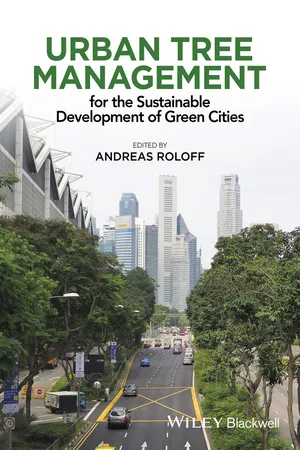
- English
- ePUB (mobile friendly)
- Available on iOS & Android
About this book
Urban tree management is the key basis for greener cities of the future. It is a practical discipline which includes tree selection, planting, care and protection and the overall management of trees as a collective resource.
Urban Tree Management aims to raise awareness for the positive impacts and benefits of city trees and for their importance to city dwellers. It describes their advantages and details their effects on quality of urban life and well-being – aspects that are increasingly important in these times of progressing urbanisation.
With this book you will learn:
- fundamentals, methods and tools of urban tree management
- state of the art in the fields of urban forestry and tree biology
- positive effects and uses of urban trees
- features, requirements and selection criteria for urban trees
- conditions and problems of urban trees
- governance and management aspects
- environmental education programs.
Edited by the leading expert Dr Andreas Roloff, Urban Tree Management is an excellent resource for plant scientists, horticulturists, dendrologists, arborists and arboriculturists, forestry scientists, city planners, parks department specialists and landscape architects. It will be an essential addition to all students and libraries where such subjects are taught.
Frequently asked questions
- Essential is ideal for learners and professionals who enjoy exploring a wide range of subjects. Access the Essential Library with 800,000+ trusted titles and best-sellers across business, personal growth, and the humanities. Includes unlimited reading time and Standard Read Aloud voice.
- Complete: Perfect for advanced learners and researchers needing full, unrestricted access. Unlock 1.4M+ books across hundreds of subjects, including academic and specialized titles. The Complete Plan also includes advanced features like Premium Read Aloud and Research Assistant.
Please note we cannot support devices running on iOS 13 and Android 7 or earlier. Learn more about using the app.
Information
CHAPTER 1
Intro: Urban trees – Importance, benefits, problems
1.1 Introduction
“If I knew the world would end tomorrow, I would still plant another tree today.”– Martin Luther


1.2 Aesthetics, sensory impressions
1.3 Psychology, well-being, health

Table of contents
- Title Page
- Table of Contents
- List of contributors
- CHAPTER 1: Intro: Urban trees – Importance, benefits, problems
- CHAPTER 2: Urban trees: Features andrequirements
- CHAPTER 3: Fundamentals of tree biologyfor urban trees
- CHAPTER 4: Urban tree roots: problems and peculiarities
- CHAPTER 5: Drought stress: Adaptation strategies
- CHAPTER 6: Aspects of urban tree pathology
- CHAPTER 7: Vitality assessment, tree architecture
- CHAPTER 8: Body language of trees, tree diagnostics
- CHAPTER 9: Tree inventory, risk assessment and management
- CHAPTER 10: Tree preservation, maintenance and repair
- CHAPTER 11: Tree pruning: Methods and parameters
- CHAPTER 12: Transplanting large trees
- CHAPTER 13: Dust and noise reduction
- CHAPTER 14: Invasive species, indigenous vs. alien dendroflora
- CHAPTER 15: Criteria for species selection: Development of a database for urban trees
- CHAPTER 16: Genetic aspects
- CHAPTER 17: Governance in urban forestry
- CHAPTER 18: Allotment gardens and privately managed green space in urban environment
- CHAPTER 19: Urban woods for relaxation and inspiration
- CHAPTER 20: Acceptance for urban trees: Environmental education programs
- Index
- End User License Agreement